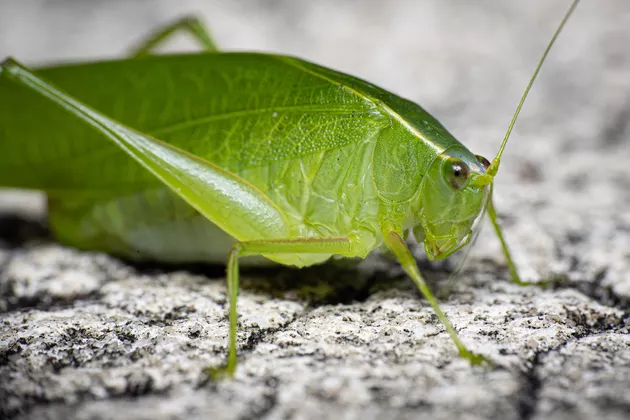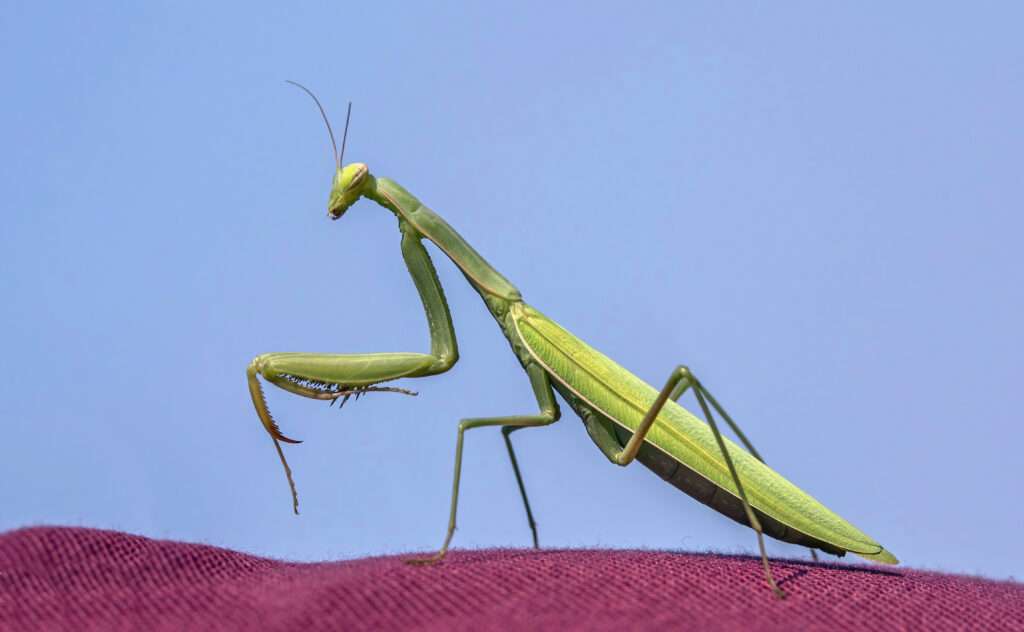
Especially in North America, insects belonging to the Tettigoniidae family are frequently referred to as bush crickets or katydids. They were formerly referred to as “long-horned grasshoppers.” Over 8,000 species have been identified. With loud mating sounds, they are primarily nocturnal in their habits. Many species engage in mimicry and camouflage, frequently adopting leaf-like forms and colors.
Physical Appearance
Katydids are large to medium-sized insects. They are mostly green, but occasionally have brown patterns. They have long thin legs and a thick body that is typically higher than it is wide. The hind legs, which are utilized for jumping frequently, are longer than the front or middle legs.
Head
They have chewing mouthparts and long, slender antennae that extend back at least as far as the insect’s abdomen on the head. All katydid species are camouflaged to blend in with the foliage they feed on, and the adults of some katydid species can fly. All species have unique features on their front wings that can be rubbed together to produce noises. They have flat spots on their legs that function as ears and pick up these sounds.
Abdomen
The abdomen of a female has a long, pointy structure at the end, and she is often larger than a male. Although it appears to be a stinger, this object is actually a “ovipositor.” They employ it to secure their eggs to plant stems or the soil.

Habitat
The planet is home to hundreds of different species of katydids. The highest diversity of katydid species, like with other insect groups, can be found in tropical regions. There are roughly 20 species in Michigan. Katydids require habitats with many plants since they spend the most of their lives feeding on the plants they consume. Any area containing plants will often have at least a few katydid species because they can survive in a variety of conditions.
Feeding
In general, katydids eat leaves. They occasionally consume other plant parts (especially flowers). In addition, they may consume aphids and other sluggish-moving insects as well as insects that have died. Some creatures in the tropics are quite carnivorous.
Life Cycle
Usually oval in shape, eggs can be fastened in rows to plants. How the ovipositor is created has an impact on where the eggs are laid. It has up to three pairs of appendages that are used to move, prepare, and properly place the egg. Tettigoniidae either have uniformly long ovipositors that lay eggs in sickle-shaped ovipositors or grass stems that commonly lay eggs in living or dead plant material. When tettigoniidae hatch, the nymphs frequently resemble tiny, wingless versions of the adults. Only when the nymphs are big enough to avoid predators do they remain in a mimic form. They are ready to mate once their final molt is complete (after roughly 5 successful molts).
Requirements to Keep as Pet
- Get a tank that is at least 30 by 30 by 30 cm (12 by 12 by 12 in) in size and that is vented. This tank will be large enough to accommodate a pair of katydids, though it’s okay to use a larger tank. To guarantee that the tank is properly ventilated, make sure that at least 1 of the sides is constructed of mesh or gauze.
- Substratum should extend 5 to 8 centimeters (2.0 to 3.1 in) above the tank’s bottom.
- Maintain the tank’s temperature between 77 and 86 °F (25 to 30 °C). Since katydid will also want a source of light other than direct sunshine, using a light bulb is the best option. For optimal results, locate the light in the tank’s top and use a bulb with a wattage of between 15 and 25.
- To optimize space, keep the quantity of decoration in the tank to a minimum. Katydid doesn’t require much in the way of decoration because the leaves you feed it will serve as adornment in and of themselves. Use a “less is more” philosophy when it comes to decorating the tank because insects need a lot of vertical space to be able to molt.
Species Number
There are around 6,400 species in the world, with the tropics having the highest variety. Since different taxonomists have different categorization systems, their classification is not well-established. The majority of North American species are classified into seven to ten subfamilies under the family Tettigoniidae.
- Broad-winged katydid
- Mediterranean katydid
- Slender meadow katydid
- Modest katydid
- Common true katydid
Table





